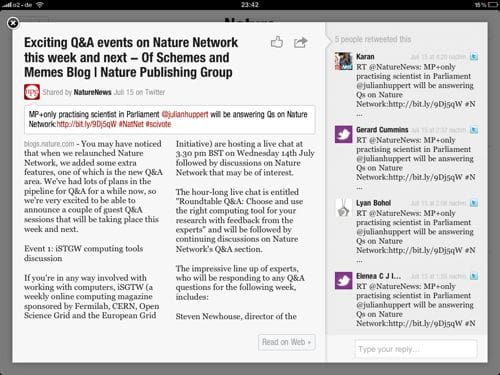Flipboard is a personalized social magazine for the iPad. The free application was released on July 22, and instantly created a lot of buzz. Because of the overwhelming interest, they had to create a waitlist for the personal features and I could only sign up for and start using them a few days ago. Flipboard is a true iPad application, it would not work the same on a laptop computer or mobile phone.
Flipboard allows you to set up nine sections for different content. You can select them from a predefined list, but the really interesting part is to create your own sections from Twitter users or Twitter lists.
You can also create a section with all the Twitter accounts you follow. Flipboard will display Tweets in a visually pleasing way. Flipboard doesn't display all Tweets in your Twitter timeline but filters the most popular and interesting tweets.
But Flipboard does something else. Rather than just displaying tweets, it follows the links provided in your Twitter stream and displays that information (photos, YouTube videos, blog posts, etc.). It can't handle all the links and for example has problems with links to FriendFeed (very common in my Twitter feed).
To filter the information, you can also create sections from Twitter lists (or individual users). I had created lists with Science Journals (@mfenner/science-journals) and Nature Network (@mfenner/nature-network) bloggers in the past.
Twitter lists are great for following meetings (e.g. @BoraZ/scienceonline2010), but unfortunately Flipboard doesn't yet allow to create sections from Twitter hashtags (e.g. #scifoo).
When you click on an individual entry, you will see a longer text, and also Tweets referring to that time as well as a link to the full-text article.

Flipboard does something similar with your Facebook News Feed. It is important to understand that Flipboard is not an RSS reader, but rather a visually pleasing aggregator from News in your Twitter and Facebook networks. Flipboard doesn't present all the information in these networks, but rather filters the most popular and “interesting” stuff.
How is Flipboard relevant to reading scholarly papers? It can be used out of the box for journals that tweet their table of contents or at least the most interesting papers. And everybody can create a Twitter account that retweets interesting papers in a particular subject area or from a particular institution (ideally this should be integrated with a bookmarking tool such as CiteULike). Scientific publishers could also work with Flipboard to integrate their content (you see in the example above that the scraping used by flipboard sometimes isn't perfect). Almost all scientific papers have an abstract. The abstract would display well in Flipboard, and could then link to the full text at the journal site.
To get started reading science blogs on Flipboard, add a ResearchBlogging.org section by subscribing to the @ResearchBlogs Twitter account.
Flipboard is of course also a great tool to follow science blogs. It probably works best if a new Twitter account is set up just for that purpose. This account could announce all new posts from a particular blog, or about a particular topic. Twitter lists could then be used for blogging networks such as Nature Network or Scienceblogs.com. Flipboard would also work very well to cover the blogging and tweeting of scientific conferences. With all these activities we will very soon need more than the nine sections that Flipboard supports.
Update 08/01/10: Added ResearchBlogging.org screenshot.


